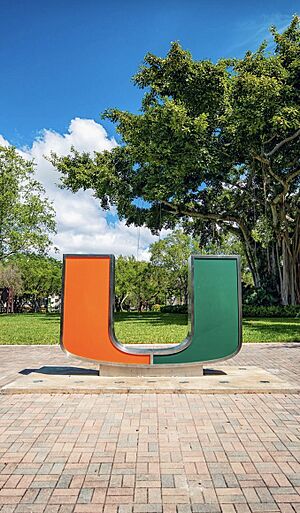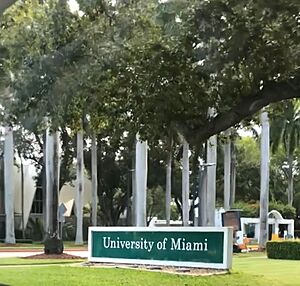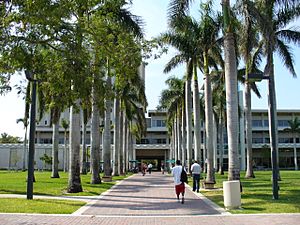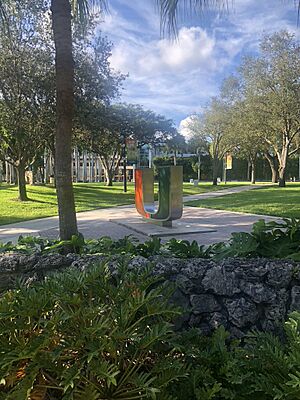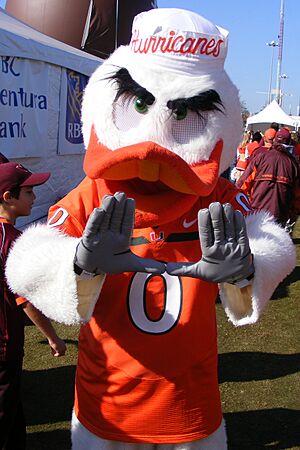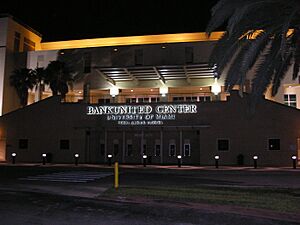University of Miami facts for kids
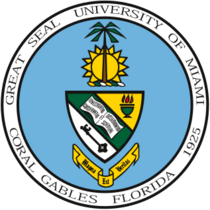 |
|
| Motto | Magna est veritas (Latin) |
|---|---|
|
Motto in English
|
"Great is the truth" |
| Type | Private research university |
| Established | April 8, 1925 |
| Accreditation | SACSCOC and 26 others |
|
Academic affiliations
|
|
| Endowment | $1.59 billion (2024) |
| Budget | $5.7 billion (2024) |
| President | Joe Echevarria |
| Provost | Guillermo Prado |
|
Academic staff
|
3,605 (fall 2024) |
|
Administrative staff
|
17,403 (fall 2024) |
| Students | 19,852 (fall 2024) |
| Undergraduates | 12,913 (fall 2024) |
| Postgraduates | 6,602 (fall 2024) |
| Location |
,
Florida
,
United States
25°43′18″N 80°16′45″W / 25.7216°N 80.2793°W |
| Campus | Small city, 453 acres (1.83 km2) (total) |
| Newspaper | The Miami Hurricane |
| Colors | Orange, white and green |
| Nickname | Hurricanes |
|
Sporting affiliations
|
|
| Mascot | Sebastian the Ibis |
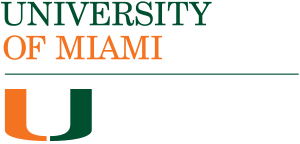 |
|
The University of Miami (often called UM, UMiami, or The U) is a private research university located in Coral Gables, Florida, United States. In 2024, nearly 20,000 students attended the university. They could choose from over 350 different subjects and programs.
The university has several campuses. The main campus is in Coral Gables. There's also the Miller School of Medicine in Miami's Health District. The law school is on the main campus. The Rosenstiel School of Marine, Atmospheric, and Earth Science is on Virginia Key.
The University of Miami offers many different degrees. These include 151 undergraduate, 149 master's, and 68 doctoral programs. With over 20,000 staff members in 2024, it's one of the biggest employers in Miami-Dade County. The main campus in Coral Gables covers about 240 acres. It's located about 7 miles southwest of downtown Miami.
The University of Miami is known for its research. It spends about $492 million each year on research projects. This makes it one of the top research universities in the nation.
As of 2024, the University of Miami has over 235,000 former students. These alumni live in all 50 U.S. states and 174 other countries. Many famous professors have taught at the university, including four Nobel Prize winners. The university is recognized for its "Very high research activity." It is also a member of the Association of American Universities.
The University of Miami's sports teams are called the Miami Hurricanes. They compete in NCAA Division I. The football team has won five national championships since 1983. The baseball team has won four national championships since 1982.
Contents
University History and Growth
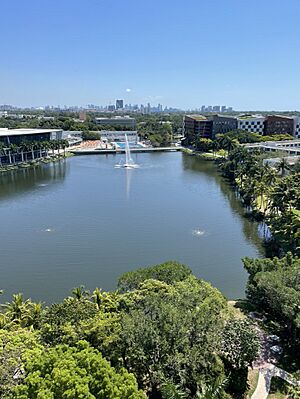
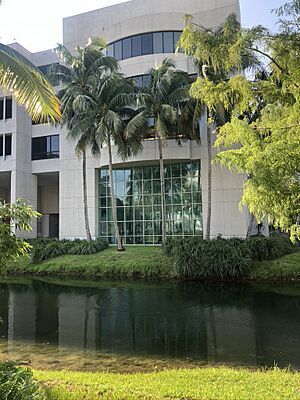
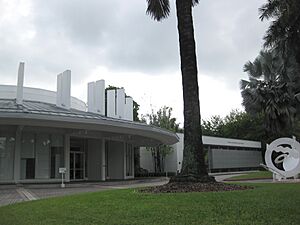
Early Days and Challenges (1925-1952)
The University of Miami was started in 1925 by a group of people who wanted to create a special university. They hoped it would focus on studies about the Americas, arts, and tropical research. George E. Merrick, who founded Coral Gables, gave 160 acres of land and nearly $5 million to help start the university.
However, soon after the first 372 students enrolled in 1926, the economy faced problems. A big hurricane in 1926 also caused damage. For the next 15 years, the university struggled financially. The first building was only half-built for a long time. Classes were held in a nearby hotel, which led to the nickname "Cardboard College."
Students even went door-to-door to collect money to keep the university open. In 1932, the university had to declare bankruptcy. But things soon got better. In 1934, the university was reorganized. During the presidency of Bowman Foster Ashe, the university grew a lot. It added new schools like the School of Law (1928), School of Business (1929), and the School of Medicine (1952).
During World War II, the University of Miami was one of only 131 universities that helped train U.S. Navy officers.
Growth and New Opportunities (1952-1981)
In 1952, Jay F. W. Pearson became the university's second president. Under his leadership, the university started offering its first Ph.D. degrees. Student numbers also grew, reaching over 4,000.
In 1961, the university changed its rules and began admitting Black students. They were allowed to participate fully in all student activities and sports. In 1966, Ray Bellamy became the first major Black college athlete in the Deep South to receive a sports scholarship at the University of Miami.
The university also started to change rules for female students. In 1971, it created a Women's Commission. This led to more fair funding for women's sports. In 1973, Terry Williams Munz became the first woman in the nation to get a sports scholarship for golf at the University of Miami.
Henry King Stanford became the third president in 1962. He focused on increasing research at the university. New research centers were created during his time. The university also started actively inviting international students in 1965.
Modern Era and Expansion (1981-Present)
Edward T. Foote II became president in 1981. He worked to attract top students and professors. He also started a big fundraising campaign that raised over $500 million. During his time, the university's special fund (endowment) grew almost ten times larger. He also created three new schools: Architecture, Communication, and International Studies.
In 2000, Donna Shalala became the university's fifth president. She had been a U.S. Secretary of Health and Human Services. Under her leadership, many new buildings were constructed, including libraries and dorms. The university's academic quality continued to improve.
In 2002, the university started another huge fundraising campaign. It raised $1.37 billion, which was the most ever raised by a Florida university at that time. A large part of this money went to improve the Miller School of Medicine. In 2007, the university bought Cedars Medical Center, renaming it University of Miami Hospital. This gave the medical school its own teaching hospital.
In 2004, the University of Miami hosted one of the U.S. presidential debates. It was watched by 62.5 million people.
Julio Frenk became the sixth president in 2015. He had been a dean at Harvard University. In 2016, the university hosted another important event: a Republican presidential primary debate.
In June 2024, Julio Frenk announced he would be leaving the University of Miami. Joe Echevarria, who was the university's chief executive, was appointed acting president. On October 18, 2024, Joe Echevarria was officially named the seventh president of the University of Miami.
University Campuses
Coral Gables Main Campus
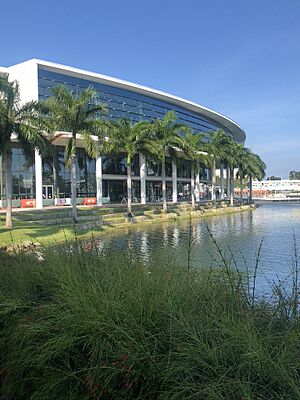
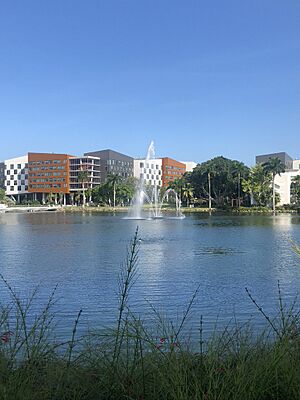
The University of Miami's main campus is in Coral Gables, Florida. It covers 240 acres and is about 7 miles southwest of downtown Miami. Most of the university's classes and programs are on this campus. It has eight schools and two colleges, including the Frost School of Music and the University of Miami School of Law.
The campus has over 5.9 million square feet of buildings. At the center of campus is Lake Osceola, a man-made lake. The campus theater is named after Jerry Herman, a famous Broadway composer who went to the university.
The John C. Gifford Arboretum, a garden with many different trees, is on the campus. The School of Architecture also has exhibitions about design.
Getting to the Coral Gables campus is easy. The Miami Metrorail has a "University Station" stop right near campus. This connects the university to downtown Miami, the airport, and other areas. The university also has shuttle buses and a Zipcar service.
In 2018, the famous rap artist Drake filmed parts of his music video "God's Plan" on the University of Miami campus.
Student Living on Campus
The main campus in Coral Gables houses 4,590 students. Most of these are first-year students. The university has five residential colleges and an apartment-style area for older students. Some older dorms were taken down to build a new area called Centennial Village, which started opening in fall 2024.
Lakeside Village is another large residential complex. It has 25 connected buildings and houses over 1,100 students.
Medical School Campus
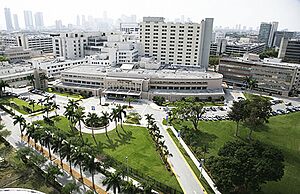
The University of Miami's Miller School of Medicine is located in Miami's Health District. In 2024, it had 1,681 full-time professors and 785 students. The campus covers 70 acres. Two of its medical programs are ranked nationally: the Bascom Palmer Eye Institute (ranked first in the nation) and neurology/neurosurgery (ranked 25th).
The medical center includes three hospitals owned by the University of Miami: University of Miami Hospital, Sylvester Comprehensive Cancer Center, and Anne Bates Leach Eye Hospital. Other hospitals like Jackson Memorial Hospital are also on the campus and work with the university. The oldest building on the medical campus is known as "The Alamo" and is a historic place.
In 2006, the university opened a large Clinical Research Building. In 2007, it bought Cedars Medical Center and renamed it University of Miami Hospital. A new biomedical research building opened in 2009. The university also has a Life Science Park next to the medical campus. The medical campus is connected to the main campus by the Metrorail.
Marine and Atmospheric Science Campus
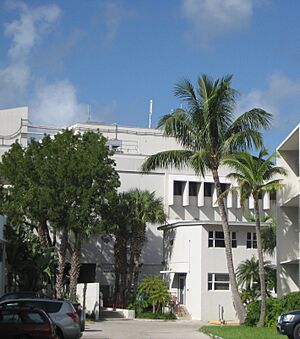
The Rosenstiel School of Marine, Atmospheric, and Earth Science has its own campus on Virginia Key. It's the only research institute in the continental U.S. that focuses on subtropical marine and atmospheric studies. The school has the world's largest hurricane simulation tank. It also works closely with a federal research lab nearby.
The school has a research facility in Barbados. It studies how dust from the Sahara Desert travels across the Atlantic Ocean. The school started in 1945. Since 1951, it has published a scientific journal called the Bulletin of Marine Science. In 2009, the university received a grant to build a new Marine Technology and Life Sciences Seawater Research Building.
South and Richmond Campuses
After World War II, the University of Miami acquired the former Richmond Naval Air Station. This property helped house the many new students. Later, it became a research facility. Another part of the property, called South Campus, was used for agricultural research.
The Richmond campus is a 76-acre site. It used to be a U.S. Naval Observatory facility. Now, the Rosenstiel School uses parts of this campus for its research.
University Libraries
The University of Miami has one of the largest university library systems in the nation. It has over four million books and many other resources. There are eight libraries in total.
Four libraries are on the Coral Gables campus:
- Otto G. Richter Library: The main library for many subjects.
- Architecture Research Center
- Judi Prokop Newman Information Resource Center (at the Business School)
- Marta and Austin Weeks Library (at the Frost School of Music)
The Miller School of Medicine has its main library, Louis Calder Memorial Library, on the medical campus. It also has two specialized medical libraries. The Rosenstiel School has its own library on Virginia Key.
The Richter Library has special collections, including rare books and maps. Its Cuban Heritage Collection has the largest collection of Cuba-related materials outside of Cuba. In 2017, the university received a large donation of rare books and maps. These are now housed in the Kislak Center. This center also holds a copy of Christopher Columbus's original letter about his first voyage in 1493.
Academics and Learning
The University of Miami has 2,850 full-time professors. Almost all of them have the highest degrees in their fields. There is one professor for every 12 students.
University Accreditation
The University of Miami is officially recognized by many groups. This means its programs meet high standards. It is accredited by the Southern Association of Colleges and Schools and the Florida Department of Education. It also has 26 other special accreditations for different programs, like medicine, law, and business.
The university is a member of several important academic associations. In 2022, the Miami Herbert Business School received a special "triple crown" accreditation. This means it's recognized by the top three business school accrediting bodies in the world. Less than one percent of business schools have this honor.
Becoming a Student
| 2023 | 2022 | 2021 | 2020 | 2019 | 2018 | |
|---|---|---|---|---|---|---|
| Applicants | 48,286 | 49,167 | 42,244 | 40,131 | 38,919 | 34,279 |
| Admits | 8,940 | 9,311 | 12,036 | 13,280 | 10,557 | 11,020 |
| Enrolls | 2,328 | 2,371 | 2,766 | 2,358 | 2,203 | 2,366 |
| Admit rate | 18.5% | 18.9% | 28.5% | 33.1% | 27.1% | 32.1% |
| Yield rate | 26.0% | 25.5% | 23.0% | 17.8% | 20.9% | 21.5% |
| SAT composite* | 1340-1450 (32%†) |
1330–1450 (35%†) |
1310–1450 (31%†) |
1260–1400 (55%†) |
1280–1420 (57%†) |
1250–1430 (51%†) |
| ACT composite* | 30–33 (21%†) |
30–33 (22%†) |
30–33 (24%†) |
28–32 (40%†) |
29–32 (38%†) |
29–32 (43%†) |
| * middle 50% range † percentage of first-time freshmen who chose to submit |
||||||
It is quite competitive to get into the University of Miami. It is the most selective university in Florida. In fall 2024, 37% of new students were in the top 5% of their high school class.
For the class that started in fall 2023, the university received over 48,000 applications. Only about 18.5% of applicants were accepted. Of those accepted, 26% chose to attend.
The average SAT score for students starting in fall 2024 was 1400. The average ACT score was 31. The average high school GPA was 3.8 out of 4.0.
Students come to the University of Miami from all over the world. In 2024, 18% of undergraduate students were from the Miami area. 10% were from other parts of Florida. 65% were from other U.S. states, and 7% were international students. The university is known for its diversity.
Most students stay at the university after their first year (93% retention rate). About 84% of students graduate within six years.
| School | Tuition | Total cost |
|---|---|---|
| Undergraduate | $50,226 | $68,458 |
| Graduate school | $37,624 | $64,776 |
| Law school | $52,390 | $80,168 |
| Medical school (in-state Florida residents) | $40,494 | $69,051 |
| Medical school (non-Florida residents) | $44,107 | $72,664 |
University Structure
The University of Miami is managed by a board of trustees. This board includes elected members, alumni, and others. They help oversee the university's 12 academic units.
Each of the university's 12 schools and colleges has a dean who leads it. These include:
- College of Arts and Sciences
- College of Engineering
- Frost School of Music
- Herbert Business School
- Rosenstiel School of Marine, Atmospheric, and Earth Science
- School of Architecture
- School of Communication
- School of Education and Human Development
- School of Nursing and Health Studies
- Miller School of Medicine (for graduate students only)
- The Graduate School
- University of Miami School of Law (for graduate students only)
The university also has programs for continuing education and executive education. Students can even take graduate classes at Florida International University through a special partnership.
The University of Miami has a program called The Launch Pad. It helps students from all majors start and grow their own businesses. They can get legal help and connect with investors who support university-related businesses.
The Miller School of Medicine offers medical degrees and PhDs in biomedical sciences. Its Department of Community Service provides free medical services to the community.
University Rankings
The University of Miami is highly ranked among national universities. In 2023, U.S. News & World Report ranked it 67th. The Miller School of Medicine was ranked the 44th-best medical school. The School of Law was ranked 71st.
In 2022, the Academic Ranking of World Universities ranked the University of Miami as the 9th-best university in the world for oceanography. It was also ranked 25th for business administration.
|
|
|
||||||||||||||||||||||||||||||||||||||||||||||||||||||||||||||||||||||||||||||||||||||||||||||||||||||||
University Research
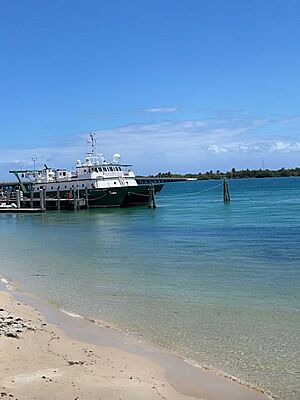
The University of Miami is known for its "Very High Research Activity." In 2023, it spent $456 million on research and sponsored programs.
Besides research in its schools, the university has several special research centers:
- Abess Center for Ecosystem Science and Policy: Connects science with environmental rules.
- Center for Research and Education for Aging and Technology Enhancement (CREATE): Looks for ways to improve life for older adults.
- Computational Science Center: Uses data to find solutions for world problems.
- European Union Center: Studies economic, social, and political issues related to the European Union.
- Institute for Cuban and Cuban-American Studies (ICCAS): Provides research on Cuba.
- John P. Hussman Institute for Human Genomics: Researches diseases like Parkinson's and Alzheimer's. It also explores the human genome for cures.
- The Sue and Leonard Miller Center for Contemporary Judaic Studies: Explores issues affecting the Jewish people.
- The Wallace H. Coulter Center: Turns biomedical research into new healthcare products.
The Miller School of Medicine receives over $200 million each year for research. It has 1,500 ongoing projects. The medical campus has over 500,000 square feet of research space. The Life Science Park adds even more space. The Interdisciplinary Stem Cell Institute researches stem cells for new treatments.
The University of Miami has one of the largest computer systems for academic research. It supports over 1,200 users and has a lot of computing power and storage.
The Rosenstiel School of Marine, Atmospheric, and Earth Science receives $50 million annually for research. Its labs have special equipment like a saltwater wave tank and DNA profiling tools. The school also has an invertebrate museum with 400,000 specimens. The university operates a research station in the Bahamas and an observatory in Bermuda. It also owns Little Salt Spring, a historic site where it does archaeological research.
In 2010, the university built a brain imaging annex. It has a special fMRI system to study brain function. This lab was partly funded by a $14.8 million grant.
In 2016, the university received $195 million in federal research funding. The Miller School of Medicine received a record $149.5 million in funding in 2019. This made it the largest recipient of this type of grant among medical schools in Florida.
Student Life and Activities
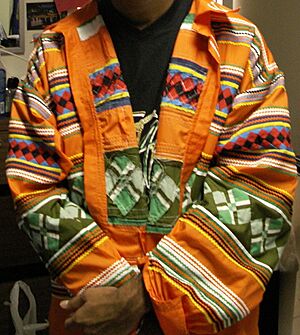
The University of Miami has 31 social fraternities and sororities. These include groups for different cultures, like African-American, Latino, and Asian students.
There are over 300 student organizations at the university. These include groups like Amnesty International and Habitat for Humanity. Students also run a yearbook, a TV channel (UMTV), a Spanish TV broadcast (UniMiami), a magazine (Distraction Magazine), and a radio station (WVUM). Since 1929, students have published The Miami Hurricane newspaper, which is now published weekly.
University Athletics
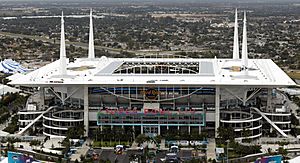

The University of Miami's sports teams are called the Miami Hurricanes. People often call them "The 'Canes" or "The U." They play in NCAA Division I and are part of the Atlantic Coast Conference (ACC). The Hurricanes have seven men's teams and ten women's teams.
The university's mascot is Sebastian the Ibis, first introduced in 1957. The marching band, started in 1933, is called Band of the Hour.
Football Team Success
The University of Miami football team has won five national championships. These were in 1983, 1987, 1989, 1991, and 2001. Many players from the University of Miami have gone on to play in the NFL. Eleven of them are in the Pro Football Hall of Fame. Two players have won the Heisman Trophy.
Since the 1980s, the University of Miami football program has become very famous. It has a large and passionate fan base around the world. The team has produced many successful players. Its history, including the 2001 national championship team, is considered one of the best in college football.
The Hurricanes play their home games at Hard Rock Stadium in Miami Gardens. They have a contract to play there until 2033. Before that, they played at the Miami Orange Bowl.
Baseball Team Achievements
The University of Miami baseball team has also been very successful. It has won four national championships in 1982, 1985, 1999, and 2001. Many Miami Hurricanes baseball players have gone on to play in Major League Baseball.
The baseball team plays its home games at Alex Rodriguez Park at Mark Light Field. This stadium is named after New York Yankees player Alex Rodriguez, who helped fund its renovation.
Basketball Teams
The University of Miami's men's basketball team has reached the Sweet 16 of the NCAA tournament five times. They reached the Elite Eight twice and the Final Four once in 2022–2023. Some players have gone on to play in the NBA.
In 2022–23, the University of Miami's women's basketball team reached the NCAA Elite Eight for the first time. Some of its players have gone on to play in the WNBA.
Both basketball teams play their home games at Watsco Center. This indoor stadium on campus can hold 8,000 people.
Other Sports
Players from the University of Miami's tennis program have achieved success as amateurs and professionals. These include Wimbledon champions and Olympic medalists.
The University of Miami women's soccer team and both its men's and women's track and field teams play their home games at Cobb Stadium. This stadium opened in 1999 on campus.
Notable People from the University
Famous Alumni
Many University of Miami alumni have become famous and influential in their fields. These include former presidents of countries like Honduras, Peru, and Belize. There are also economists, poets, and actors like Dwayne "The Rock" Johnson.
Grammy Award-winning musicians like Gloria Estefan, Bruce Hornsby, Enrique Iglesias, and Jon Secada also attended the university. Many alumni are also CEOs, public officials, scientists, and professional athletes in the NFL, NBA, and Major League Baseball. This includes eleven members of the NFL Pro Football Hall of Fame.
Notable Faculty Members
Many notable academics have taught at the University of Miami. This includes four Nobel Prize winners. Experts from almost every subject have taught there.
Some famous faculty members include physicist Paul Dirac, biochemists Robert F. Furchgott and Earl Wilbur Sutherland Jr., and writers Juan Ramón Jiménez. Former U.S. Secretary of Health and Services Donna Shalala also taught there. Musicians like Jaco Pastorius and Pat Metheny have also been faculty members.
See also
 In Spanish: Universidad de Miami para niños
In Spanish: Universidad de Miami para niños


